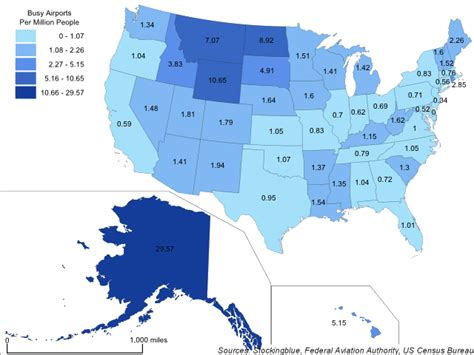Top Airports Per Capita: The Global Ranking

In the realm of air travel and aviation, it is not just the sheer number of airports that matters; the efficiency and utilization of these aerial gateways play a crucial role in defining a country's air connectivity. This article delves into the fascinating world of airports per capita, exploring which countries have the highest concentration of airports, and the factors contributing to this global ranking.
The Global Airport Landscape

As of 2023, the global aviation network boasts an impressive 50,000+ airports, ranging from international hubs to regional airstrips. These aerial ports facilitate the seamless movement of people and goods, forming the backbone of global connectivity. However, the distribution of these airports is not uniform, with certain regions and countries leading the way in terms of airport density.
The International Civil Aviation Organization (ICAO), a specialized agency of the United Nations, plays a pivotal role in managing and regulating civil aviation worldwide. ICAO's statistics provide an insightful look into the global airport landscape, highlighting the top performers in airport per capita rankings.
Top Airports Per Capita: Global Ranking

The list of countries with the highest number of airports per capita is a testament to the diverse nature of global aviation. Here's a comprehensive breakdown of the top 10 countries, along with the key factors contributing to their success:
1. United States of America
The United States takes the top spot with an impressive over 19,000 airports, which translates to approximately 59 airports per million inhabitants. The country's vast size, diverse geography, and strong aviation culture contribute to this impressive ranking. From major international hubs like JFK and LAX to countless regional airports, the US offers unparalleled air connectivity.
2. Canada
Canada, a vast country with a relatively small population, boasts an impressive over 1,400 airports, resulting in a high airport density of 34 per million people. The country's northern territories, in particular, rely heavily on air transport for connectivity, contributing to this impressive statistic.
3. Brazil
Brazil, the largest country in South America, stands out with its over 2,000 airports, giving it a strong airport per capita ranking of 11 per million inhabitants. The country's diverse landscapes, from the Amazon rainforest to urban centers, necessitate a robust aviation network.
4. Australia
With a vast landmass and a relatively small population, Australia boasts an impressive over 400 airports, resulting in a high airport density of 17 per million people. The country's unique geography and the importance of air transport for connectivity contribute to this ranking.
5. Mexico
Mexico, a country with a strong tourism industry, has an extensive aviation network with over 1,700 airports, giving it a high airport per capita ranking of 15 per million inhabitants. The country's diverse regions, from coastal resorts to urban centers, rely on air transport for connectivity.
6. Germany
Germany, a powerhouse in European aviation, boasts an impressive over 500 airports, resulting in a high airport density of 6 per million people. The country's strong industrial sector and its role as a transit hub contribute to this ranking.
7. Russia
Russia, the largest country in the world by area, has an extensive aviation network with over 1,200 airports, giving it a high airport per capita ranking of 8 per million inhabitants. The country's vast size and diverse regions necessitate a robust aviation infrastructure.
8. United Kingdom
The United Kingdom, a global aviation hub, has a well-developed aviation network with over 300 airports, resulting in a high airport density of 4 per million people. The country's historical significance in aviation and its role as a key transit point contribute to this ranking.
9. France
France, a popular tourist destination, has a strong aviation network with over 450 airports, giving it a high airport per capita ranking of 7 per million inhabitants. The country's diverse regions and its role as a key European transit point contribute to this statistic.
10. India
India, a rapidly developing country with a vast population, has an extensive aviation network with over 350 airports, resulting in a high airport density of 2 per million people. The country's growing aviation sector and its focus on regional connectivity contribute to this ranking.
| Country | Number of Airports | Airports per Million Inhabitants |
|---|---|---|
| United States | Over 19,000 | 59 |
| Canada | Over 1,400 | 34 |
| Brazil | Over 2,000 | 11 |
| Australia | Over 400 | 17 |
| Mexico | Over 1,700 | 15 |
| Germany | Over 500 | 6 |
| Russia | Over 1,200 | 8 |
| United Kingdom | Over 300 | 4 |
| France | Over 450 | 7 |
| India | Over 350 | 2 |

Factors Influencing Airport Density
The factors contributing to a country's airport density are multifaceted and can vary significantly. Here are some key aspects to consider:
- Geography and Size: Countries with vast landmasses, diverse landscapes, and remote regions often require a higher number of airports to facilitate connectivity.
- Population Distribution: A country's population density and distribution play a crucial role. Countries with a dispersed population may require more airports to serve remote areas.
- Economic Factors: The strength of a country's economy, particularly its industrial and tourism sectors, can influence the demand for air transport and subsequently, the number of airports.
- Aviation Culture: Some countries have a strong aviation culture, with a higher demand for general aviation and private flights, leading to a higher airport density.
- Historical Significance: Countries with a rich aviation history often have well-established aviation networks, contributing to their airport density rankings.
The Future of Airport Connectivity
As global aviation continues to evolve, the airport per capita rankings are set to undergo changes. The ongoing trends and developments in the aviation industry will shape the future landscape. Here are some key insights:
- Sustainable Aviation: The push for sustainable aviation practices, including the development of electric and hybrid aircraft, could influence airport infrastructure and connectivity.
- Regional Connectivity: There is a growing focus on improving regional connectivity, especially in developing countries, which may lead to an increase in airport density in these regions.
- Technology Advancements: Innovations in aviation technology, such as improved air traffic management systems and advanced navigation aids, could enhance airport efficiency and capacity.
- Airspace Management: Effective airspace management, including the optimization of air routes and airspace utilization, will be crucial in maximizing airport capacity and efficiency.
FAQs

What is the average number of airports per country globally?
+On average, there are approximately 5 to 10 airports per country worldwide, with significant variations based on factors like geography, population, and economic development.
<div class="faq-item">
<div class="faq-question">
<h3>How does airport density impact a country's economy and tourism sector?</h3>
<span class="faq-toggle">+</span>
</div>
<div class="faq-answer">
<p>A higher airport density can positively impact a country's economy by facilitating easier access to remote regions, promoting tourism, and supporting industries like logistics and trade. It can also enhance a country's global connectivity, making it more attractive for international business and tourism.</p>
</div>
</div>
<div class="faq-item">
<div class="faq-question">
<h3>What are the challenges associated with high airport density?</h3>
<span class="faq-toggle">+</span>
</div>
<div class="faq-answer">
<p>High airport density can pose challenges such as increased air traffic congestion, environmental concerns related to noise and pollution, and the need for effective airspace management to ensure safe and efficient operations.</p>
</div>
</div>
<div class="faq-item">
<div class="faq-question">
<h3>How do smaller countries with fewer airports ensure connectivity?</h3>
<span class="faq-toggle">+</span>
</div>
<div class="faq-answer">
<p>Smaller countries with fewer airports often rely on efficient use of existing infrastructure, strategic partnerships with neighboring countries for air connectivity, and the development of regional hubs to ensure adequate connectivity.</p>
</div>
</div>
<div class="faq-item">
<div class="faq-question">
<h3>What role do general aviation airports play in airport density rankings?</h3>
<span class="faq-toggle">+</span>
</div>
<div class="faq-answer">
<p>General aviation airports, which cater to private and recreational flights, contribute significantly to airport density rankings, especially in countries with a strong aviation culture and a high demand for general aviation services.</p>
</div>
</div>
</div>



